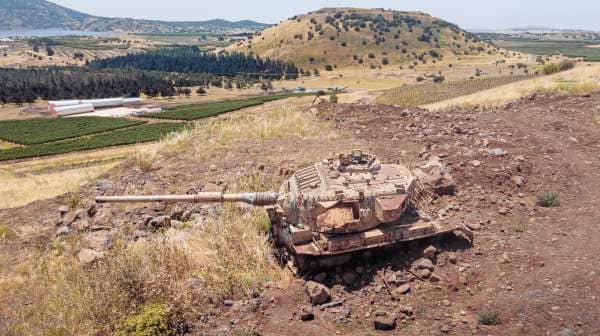During the Yom Kippur War (October 6-24, 1973) Israel faced one of the most serious external threats in its history. The official IDF studies approved for publication grant us an understanding of the scale of the threat, the heroism of the struggle, and the chain of miraculous events that clearly indicate that the Almighty was fighting on our side.
There were about 200 infantry soldiers (without anti-tank weapons) all over the Golan Heights. The Syrians, on the other hand, had six infantry battalions with commando support, antitank and reconnaissance battalions on the front line — a total of about 10,000 soldiers. The force ratio was incomparable: 50 to 1! Forty-four Israeli artillery pieces went into battle against over 1,000 enemy guns.
At 1:55 p.m. the mass bombardment began with about 25,000 shells. Syrian fighters suddenly attacked Israeli reconnaissance points. The electronic attack on the communications system caused problems in communication between the commanders and the soldiers. Within hours the stronghold on Mount Hermon was overrun, seriously limiting reconnaissance capacity at this time. The 188th Brigade took charge of the southern plateau, while the 7th Brigade fought in the north. During this entire time, a small group of Israeli fighters fought selflessly against the Syrian assaults. In the southern plateau, about 60 Israeli tanks, with almost no air support, faced heavy fire.
Despite the difficulty and power of the enemy, the few fought against the many and, with the help of the Almighty, most of the Syrian armored vehicles in the first wave were damaged. In the evening hours, however, the Syrians sent reinforcements to the south — four new brigades with about 330 tanks, and about 20-30 more tanks remained at the front!
By morning, 330 additional tanks had joined the first tank division along with the 47th Brigade.
The Syrians also got to the main headquarters in the area and the IDF commanders had to evacuate from there. As a result of the military actions, the commander of the 188th Brigade, his deputy and another officer were killed. At 4:30 pm (the end of the holy day of Yom Kippur) orders were given to destroy all classified material (maps, military documents, reports etc.) so that they would not fall into enemy hands. The Minister of Defense, Moshe Dayan, who considered the danger of the situation, ordered that the bridges over the Jordan River have to be mined because of the serious danger of the Syrian invasion. He also appealed to the commander of the air force to “prevent the destruction of the Third Temple”. Many of the pilots were sent to their certain deaths, and they realized it: they should have fired at the Syrian armored vehicles from the air, but despite their efforts, the enemy infiltration did not stop.
Day 13 of Tishrei that year was a turning point in the war effort. It is amazing that according to the Chassidic calendar, this was the day the Rebbe MAARASH (Rabbi Shmuel) — the fifth head of Chabad — left the physical world, whose famous saying was: “Initially — to break through”. That was the manner in which the Israeli soldiers acted, and their counter-attack was successful.
Why, after all, with such power, the Syrians didn’t approach Lake Kinneret?
Until today, there is no clear answer to this question. Some military analysts have argued that this was not originally the part of the Syrian plans. However, there are several facts that contradict this claim. The first is that fostering success is one of the basic principles of warfare. Secondly, according to the official conclusion of the IDF, according to the maps captured from the enemy, Syria was planning to conquer the bridges over the Jordan and reach Kinneret. There was another version to explain what was happening, arguing that the Syrians had run out of fuel. But the fact that the Syrians abandoned hundreds of pieces of their military equipment during the war denies this explanation. The Israeli air force was unable to stop the Syrians, and they were able to advance under the cover of the “SA-6” anti-aircraft missile system. The Israeli reserve forces, which began to arrive little by little, even at that point could not have confronted the Syrians if they chose to occupy their positions and break forward.
A similar question arises on the southern front. The 450 fighters in the fortified area were facing 90,000 enemy soldiers, an unimaginable ratio of 200 to 1! On the first day of the battle, 200 Israeli tanks were hit (their total number on the southern front was 300) and the Egyptians could have broken through, under the cover of “SA-6”, but they were stopped...
Amazingly, with the beginning of the Yom Kippur War, the Lubavitcher Rebbe King Moshiach SHLITA said that there would be more miracles than during the Six Day War. Indeed, the Israeli army could not compare to the enemy army in terms of equipment and soldiers, but when our forces were undermined, the enemy was nevertheless relinquished...
The operation on the Egyptian side ended as a success on the holiday of Sukkot — 20 Tishrei, which is the day according to Chassidic custom when an important guest comes to visit us — the Rebbe MAARASH...
What more can I add? Miracles, indeed!
